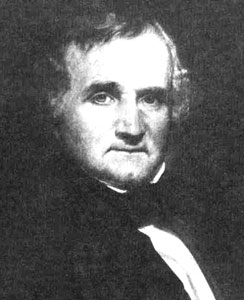
John Catron
John Catron served as first chief justice of the Tennessee Supreme Court and later as associate justice of the U.S. Supreme Court. He was probably born in Virginia in the mid-1780s and received a meager education in the common schools of Virginia and Kentucky. In 1807 Catron married Mary Childress, a native of Nashville. Five years later the couple moved to Tennessee, where they settled at Sparta. After serving briefly under General Andrew Jackson in the Alabama campaigns against the Creek Indians, Catron returned to Sparta, studied law, and began to practice his profession before moving to Nashville in 1818.
Despite his lack of formal education, Catron built a reputation in the law. He gave up his Nashville practice for a two-year term as attorney general for the third circuit, which covered seven Middle Tennessee counties. In 1824 the legislature elected him judge of the Tennessee Supreme Court of Errors and Appeals, and in 1831 he became its first chief justice.
During his twelve years of service on the court, Catron wrote important opinions regarding conflicting land titles, homicide and self-defense, slavery and free blacks, and the status of Native Americans. Perhaps most notable at the time was Catron’s opinion in Love v. Love (1828), which resolved a decades-long dispute by ruling that legal titles from the state were unnecessary for land ownership when the occupants had continuously resided on the property for seven years.
Catron’s political activities tarnished his competent judicial career. An avid Jacksonian and leader in the Tennessee Democratic Party, Catron supported the presidential ambitions of Martin Van Buren, President Jackson’s hand-picked successor, which angered the supporters of favorite son Hugh Lawson White. In 1835 the legislature retaliated by abolishing the Court of Errors and Appeals, effectively removing Catron from the state bench. The following year, the ex-chief justice managed Van Buren’s campaign in Tennessee.
Just before leaving office, President Jackson appointed Catron to the U.S. Supreme Court, and Catron took his seat as associate justice on May 1, 1837. He served for the next twenty-eight years and took part in a number of cases of constitutional significance. In the famous Dred Scott v. Sandford (1857) Catron wrote a separate opinion in concurrence with the majority. He agreed that the slave Scott remained a slave despite his occasional residence in a free territory and concurred that Congress possessed no power to interfere with slavery in the western territories.
Despite his pro-slavery judicial record, Catron opposed secession and in 1861 he traveled to Nashville to convince state leaders to remain in the Union. Warned that his life would not be safe in the secessionist-leaning city, Catron fled and did not return until June 1862, when the federal occupation of Nashville allowed him to convene the U.S. District Court there. John Catron died in his Nashville home on May 30, 1865.
Suggested Reading
Joshua W. Caldwell, Sketches of the Bench and Bar of Tennessee (1898); Melvin I. Urofsky, The Supreme Court Justices: A Biographical Dictionary (1994)



